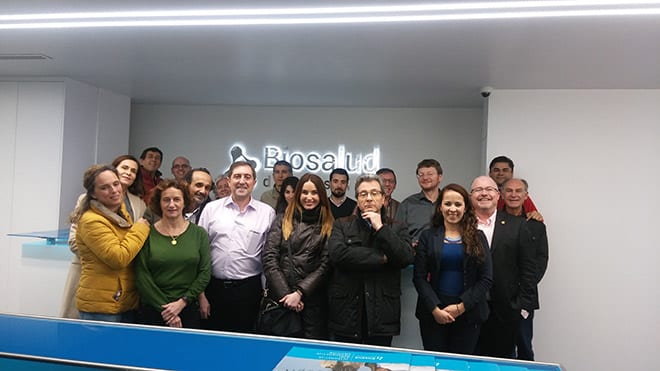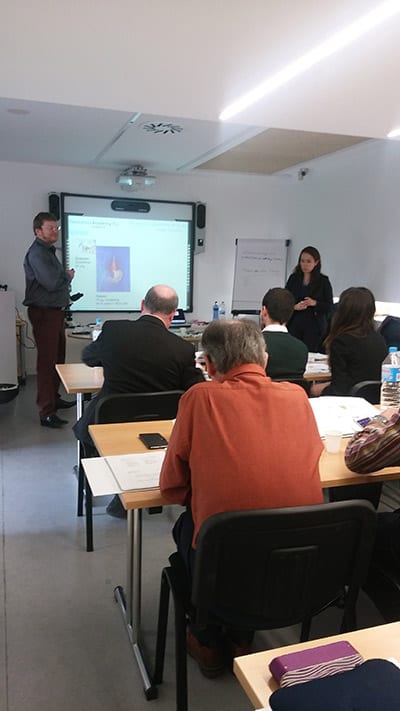
The vocation of Biosalud Day Hospital Academy
Biosalud Day Hospital aims to bring the medical community closer to the training in Biological Medicine which is not found in Spain; the courses on Complementary Diagnostic and Treatment Techniques in Biological Medicine are a good example of this.
Biosalud Day Hospital Academy has opened its training programme with a course on Complementary Diagnostic and Treatment Techniques in Biological Medicine: blood analysis with dark field microscopy and bio-neurovegetative injection therapy and procaine serotherapy. With this training, Biosalud offers the medical community in Spain the possibility to deepen in advanced techniques.
The darkfield microscopy blood tests is a source of qualitative and direct information on the state of health, as opposed to the quantitative data offered by laboratory analyses. This is why we say that we are dealing with complementary techniques.
The dr. Ralf Oetmeier, medical director of the Paracelsus Clinic in Switzerland, and former medical director of the German clinic Im LEBEN (Comprehensive Center for Biological Cancer Medicine, Diagnostic and Therapy), is a great expertise in darkfield microscopy analysis and other diagnostic and therapeutic techniques. one of the trainers of the Biosalud Academy in this first stage of their academic programme.

Oetmeier defines himself as a holistic doctor who, with the use of different techniques, works for the healing of chronic diseases or cancer. What I like about our holistic approach is one of its main characteristics, which is that we take into account the environmental aspects of the patients; in our societies we are overloaded with toxics, metals, insecticides...And we can also see this because we have an important diagnostic area with instruments like thermography or dark field microscopy and a lot of laboratory work. In terms of treatment, we do it as a team and in a holistic way and we take into account several levels of the biological system.
Blood analysis with darkfield microscopy, the technique on which he teaches the training at Biosalud Day HospitalWe call it, in his experience, a good way to teach patients. vital juicebecause the blood is seen live through the image and allows us to observe the white blood cells, red blood cells and plateletsIt is therefore a complement to the classical laboratory as it offers certainty about the qualitative aspects of blood, which is why it is a great method that allows us to analyse the phenomenon of haematology from another point of view. This analysis is then completed by laboratory tests.
With darkfield microscopy we can observe trendsFor example, from liver function, whether there is an oxygenation problem, oxidative stress, acid/base balance or toxicity, we can see a lot of things that tell us in which direction to investigate.
I especially like this technique because the patient can ask himself questions, he is looking at the picture of his cells, of his life. This way you can give him more information and the patient is more motivated and asks you what he can do to improve his health, which is one of the things I like the most, Ralf Oetmeier adds.
In relation to the training and experience of doctors using this technique, Oetmeier explains that it is easy to see what is happening, because of the clarity of the microscopy image, we define haematological phenomena with a structure that allows us to see the evidence, we are surprised because the image that is obtained is very clear, and we can see trends quickly; the efficiency with which we can see changes in cell activity, toxic phenomena, blockage of white blood cell activity, which is not a good sign because the cells should be moving…. Despite the number of haematological phenomena that can be observed, he warns against overinterpreting the phenomena in front of the patient, we cannot tell everything we see or tell stories to the patient about it, I don't like this approach, we have to explain only what we are seeing, not to interpret.

Darkfield microscopy is a simple analysis, it is important that the doctor or nurse is careful when preparing the samples; when the blood sample is taken, it is immediately put on the glass and the analysis is done live, immediately, and it can be explained to the patient why we are going to perform another type of test and a certain treatment.
The evolution of Integrative Medicine
In Latin American countries such as Colombia, Biological Medicine is integrated into universities and public health and, without yet reaching that level of penetration, in central Europe it is also highly regarded and is an equally valid option for patients. In Spain, however, there is still a long way to go and with training courses such as those offered by the BIosalud Day Hospital Academy, we can make progress in the knowledge and application of these techniques.
15 doctors from all over Spain are taking part in this Darkfield Microscopy course.. The training is oriented towards theory and case study analysis, and in practice as a few hours of real time analysis with several teams.
Ralf Oetmeier is the creator of Systemic Procaine Therapy.. Taking advantage of his stay in Zaragoza, this course on Complementary Diagnostic and Treatment Techniques in Biological Medicine includes a seminar on Neurovegetative Injection Therapy and Systemic Therapy with procaine, in collaboration with Professor Laura Pinilla, director of the Neural Therapy area of the Masters in Integrative Medicine at the National University of Colombia and Coordinator of Complementary Medicines at the Meissen Hospital in Bogota.


0 thoughts on “Formación en Medicina Integrativa”
Good afternoon, how can one go about studying biological medicine and how much does it cost?